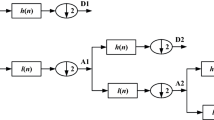Abstract
An electroencephalogram (EEG)-based brain–computer interface (BCI) system can be used to determine the intents for a paralyzed user by analyzing the EEG signals recorded from his scalp. The key technology of BCI systems is feature extraction and pattern recognition algorithm. Many of the BCI research show that nonlinear classification algorithms perform better than the linear, but they are usually far slower than required. Besides, many of these methods employ less significant features and could make the classification process less efficient. In this paper, a method is provided to identify different patterns of EEG signals. A fast nonlinear classification algorithm extreme learning machine (ELM) is provided to identify two different EEG signals. After feature extraction, we adopt a nonlinear feature selection algorithm partial mutual information-based feature selection (PMIS) to eliminate the less significant features. The experimental result shows that (1) ELM can discriminate the two patterns of EEG signals with a relatively satisfactory accuracy and (2) PMIS feature selection can find out the important features effectively and improve the classification accuracy. The final accuracy is 91.5 % against the best existed result of 88.7 % for the tested data set. The classification performance may be further improved by adding complementary features from EEG. This approach may eventually lead to a reliable EEG-based BCI studies.








Similar content being viewed by others
Explore related subjects
Discover the latest articles, news and stories from top researchers in related subjects.References
Berger H (1929) Uber has elektloenkephalogram des menschen. Eur Arch Psychiatry Clin Neurosci 98(1):231–254
Lotte F, Congedo M, Lécuyer A, Lamarche F, Arnaldi B (2007) A review of classification algorithms for eeg-based brain–computer interface. J Neural Eng 4(2):R1–R13
Schalk G, McFarland DJ, Hinterberger T, Birbaumer N, Wolpaw JR (2004) BCI2000: a general-purpose brain–computer interface (BCI) system. IEEE Trans Biomed Eng 51(6):1034–1043
Dauwels J, Vialatte F, Cichocki A (2011) On the early diagnosis of alzheimers disease from eeg signals: a mini-review. In: Advances in cognitive neurodynamics, pp 709–716
Dubois B, Feldman HH, Jacova C (2007) Research criteria for the diagnosis of alzheimers disease: revising the NINCDS-ADRDA criteria. Lancet Neurol 6(8):734–746
Blankertz B, Müller KR, Curio G, Vaughan TM, Schalk G, Wolpaw JR, Schlögl A, Neuper C, Pfurtscheller G, Hinterberger T, Schröder M, Birbaumer N (2004) The BCI competition, (2003) progress and perspectives in detection and discrimination of EEG single trials. IEEE Trans Biomed Eng 51:1044–1051
Mensh BD, Werfel J, Seung HS (2004) BCI competition 2003data set Ia: combining gamma-band power with slow cortical potentials to improve single-trial classification. IEEE Trans Biomed Eng 51:1052–1056
Li JC, Ng WY, Yeung DS, Chan PK (2014) Bi-firing deep neural networks. Int J Mach Learn Cybern 5(1):73–83
Wang XZ, Shao QY, Miao Q, Zhai JH (2013) Architecture selection for networks trained with extreme learning machine using localized generalization error model. Neurocomputing 102:3–9
Li ZQ, Zhou MT, Li H, Pu HB (2014) A two stages sparse SVM training. Int J Mach Learn Cybern 5(3):425–434
Wang XZ, Chen AX, Feng HM (2011) Upper integral network with extreme learning mechanism. Neurocomputing 74(16):2520–2525
Huang GB, Member S, Zhou HM, Ding XJ, Zhang R (2012) Extreme learning machine for regression and multiclass classification. IEEE Trans Syst Man Cybern-Part B Cybern 42(2):513–529
Fu A, Dong CR, Wang LS (2015) An experimental study on stability and generalization of extreme learning machines. Int J Mach Learn Cybern 6(1):129–135
Dietsch G (1932) Fourier-analyse von elektroencephalogrammen des menschen. Pflgers Arch 230:106–112
Sharma A (2000) Seasonal to interannual rainfall probabilistic forecasts for improved water supply management: part 1-a strategy for system predictor identification. J Hydrol 239(1–4):232–239
Sharma A, Luk KC, Cordery I, Lall U (2000) Seasonal to interannual rainfall probabilistic forecasts for improved water supply management: part 2-predictor identification of quarterly rainfall using ocean-atmosphere information. J Hydrol 239(1–4):240–248
Sharma A (2000) Seasonal to interannual rainfall probabilistic forecasts for improved water supply management: part 3-a nonparametric probabilistic forecast model. J Hydrol 239(1–4):249–258
May RJ, Maier HR, Dandy GC, Gayani-Fernando TMK (2008) Non-linear variable selection for artificial neural networks using partial mutual information. Environ Model Softw 23(10):1312–1326
May R, Dandy G, Maier H (2011) Review of input variable selection methods for artificial neural networks. In: Artificial neural networks-methodological advances and biomedical applications, pp 19–44. InTech, Rijeka
Huang GB, Zhu QY, Siew CK (2006) Extreme learning machine: theory and applications. Neurocomputing 70(1):489–501
Huang GB, Wang DH, Lan Y (2011) Extreme learning machines: a survey. Int J Mach Learn Cybern 2(2):107–122
Acknowledgments
This work was supported by the Science and Technology Key Project of Hebei Academy of Sciences under Grant No. 2014055306, the cooperation project between Chinese Academy of Sciences and Hebei Academy of Sciences, Prophase research project for the national key basic research and development program No. 2010CB535005 and Hebei major medical research project No. ZD2013079.
Author information
Authors and Affiliations
Corresponding authors
Rights and permissions
About this article
Cite this article
Zhao, H., Guo, X., Wang, M. et al. Analyze EEG signals with extreme learning machine based on PMIS feature selection. Int. J. Mach. Learn. & Cyber. 9, 243–249 (2018). https://doi.org/10.1007/s13042-015-0378-x
Received:
Accepted:
Published:
Issue Date:
DOI: https://doi.org/10.1007/s13042-015-0378-x




